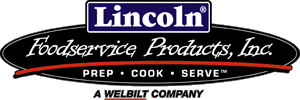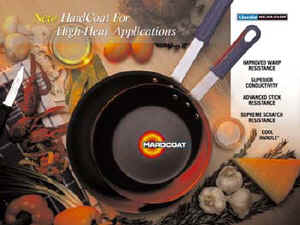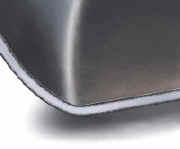|
|

|

|
 
|

|


The ultimate combination
of heat conductivity and warp resistance
In today's commercial
kitchens, time is money. So chefs require a fry pan that will
withstand high-heat cooking applications and is ready to sauté
or braise at a moment's notice. Accomplishing this task, Lincoln's
New Wear-Ever® HardCoat fry pans feature a black hard anodized
surface that retains the flexibility and even heating features of
aluminum while providing a more durable, resilient finish that resists
warping. This hardened surface is achieved by a unique electro-chemical
bonding process that unites the anodized surface with the aluminum
base, creating a non-porous, non-reactive surface that is 30% harder
than stainless steel. The HardCoat fry pan also locks in precise
temperatures, providing an even, reliable cooking surface for all
types of food. |
| Model
No. |
Description |
Case
Wight Lbs. |
Case
Cube |
Case
Pack |
View Prices |
| H4007 |
7"
Fry pan, Hard coat, Black Anodized |
6.8 |
.27 |
6 |
|
| H4008 |
8"
Fry pan, HardCoat, Black Anodized |
8.7 |
0.43 |
6 |
|
| H4010 |
10"
Fry Pan, HardCoat, Black Anodized |
13.88 |
.30 |
6 |
|
| H4012 |
12"
Fry Pan, hardCoat, Black Anodized |
8.14 |
0.61 |
2 |
|
| H4014 |
14"
Fry Pan, HardCoat, Black anodized |
11.24 |
0.97 |
2 |
|
|
What is HardCoat
HardCoat
is a surface-hardening application achieved through a unique electro-chemical
bonding process. The aluminum is united with the anodized
surface to create a hardened, non-porous and non-reactive surface.
The anodizing process causes a natural reaction between the aluminum
and the chemicals called oxidation, a process which occurs spontaneously
in nature. During this process, the product is dipped in
a large vat of chemicals and then electrically charged, resulting
in the ultimate combination of heat conductivity and warp resistance. |

|
| Improved
Warp Resistance
The
HardCoat surface slows the expansion rate of aluminum by 5 times
and increases the melting point by 30%. This combination
provides superior warp resistance over natural aluminum, even
when exposed to higher heat conditions.
To
test this theory, we subjected a natural aluminum and HardCoat
pan to severe heating and cooling conditions. Both pans
were tested by heating , on a high flame setting, to a surface
temperature of 650-700ºF and then submerged in cold water
at 60-65ºF. We repeated this cycle 45 times, which
resulted in a severely warped natural aluminum pan and a minimally
warped HardCoat pan (as shown in the photo left) |

Results after 45 cycles of
warp test
|
|



